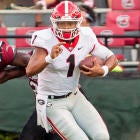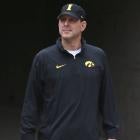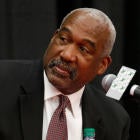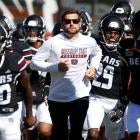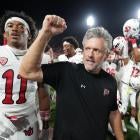Tom Mars didn't graduate at the top of his University of Arkansas School of Law class, serve as director of the Arkansas State Police and spend seven years as Wal-Mart's general counsel for this.
This is becoming the go-to attorney in obtaining freedom for college athletes seeking transfers.
"I'm no transfer magician," said Mars, the man who many consider to be just that.
The 61-year old senior counsel at Arkansas-based Friday, Eldredge & Clark has seen plenty of big-time cases in big-time courtrooms. But he didn't become a big name in college sports until he began taking on athletes seeking transfer waivers as clients.
His dogged work allowed Ole Miss quarterback Shea Patterson to become immediately eligible at Michigan last year. In part because of former Ole Miss coach Hugh Freeze's alleged missteps in recruiting, Mars also got five other former Rebels eligible right away at their new schools.
His expertise and a change in NCAA transfer rules have intersected at a place to create a new college sports culture. Consider this a summary of that new culture after the first season of transfer reform.
Mars is one of the leading figures in navigating the NCAA's thickly-worded transfer rules. Lately, the calls from parents inquiring about representation in their kids' transfer cases have averaged two per day.
Mostly, they ask how their children-athletes can become immediately eligible at a new school.
"You could tell from these voicemail messages that these people are starting to think everybody should get a waiver," Mars says of those anxious parents. "Some of them think I have the secret code."
If not, his batting average in the new transfer age is damn high. Mars is not only at the center of those transfer rule changes, he is de facto commissioner of the new culture.
You want your kid eligible right away? Hire Mars or someone like him.
In October 2018, the NCAA granted transferring athletes more freedom. No longer did these atheltes need to seek permission from a school and/or coach to transfer. No longer could those schools or coaches block undergraduates from transferring to certain schools. (Some conferences have separate rules for transferring inside their own league.)
The much-discussed transfer portal, a one-stop shopping site, sprung up and has changed college athletics forever. Athletes now merely enter their name online and wait for their phone to ring.
247Sports has created its own version of the portal that, while not complete, is currently tracking more than 160 FBS football players. That doesn't count hundreds more in 23 NCAA-sponsored sports across three divisions.
"The world changed with [transfer freedom]," said Pat Chun, Washington State's athletic director. "We got to a place where we had to get to a happy medium with the way student-athletes are changing. We have to adapt to this generation."
If not, well, this generation of athletes and their lawyers have proved themselves more than familiar with lawsuits than previous generations.
That threat may ultimately have led the NCAA to assemble a working group last year charged with transfer reform. Since at least 1964, undergraduate transfers in the five main sports (football, men's and women's basketball, hockey and baseball) had to sit out a "year in residence" at their new school.
It took more than five decades for the protests to be heard.
- Why were athletes held to a different standard than lay students, a third of whom transfer during their college careers -- obviously without penalty? "You're treating the student-athlete different than everybody else on that campus," Gonzaga AD Mike Roth told CBS Sports last year. "Nothing stops the chemistry major from leaving Gonzaga and going to the University of Washington."
- Coaches are allowed to leave at any time for the next highest-paying gig. Why can't athletes pursue a different educational and athletic setting without being controlled and penalized?
- Sitting out doesn't exactly make academic sense. Seventy-one percent of all transfer students earn a degree in four years. Meanwhile, graduation rates among athletes have climbed across the board.
Mars became a transfer magician when he was able to argue successfully for a waiver that wiped out that year in residence.
The NCAA says waivers are awarded because of a "specific, extraordinary circumstance." Is that vague enough?
"There are those waivers that have virtually no chance and those that have some chance," Mars said. "There are no slam dunks."
That new culture created new teams. Nevada basketball has an all-transfer starting five. They all arrived pre-portal, but they reflect this new culture. Forty percent of all Division I basketball players who enter directly out of high school wind up transferring by the end of their sophomore years.
For better or worse, the portal is now seen as a way to a sort of free agency, which is exactly what some coaches have labeled the new transfer freedom.
"We're all a farm league," Pittsburgh coach Pat Narduzzi said. "Everybody is kind of picking and choosing from the portal."
That has led to some rather newsworthy transfer stories.
Mars represents Georgia transfer quarterback Justin Fields, who is filing a waiver appeal so he can be eligible immediately at Ohio State. "I spent my career digging up [stuff], taking all the jigsaw pieces and telling a story," Mars said. "I do the same thing at trial. I've done the same thing in the Fields case." Mars had high praise for Buckeyes' coach Ryan Day, Ohio State compliance and the entire experience. Regarding the Fields case, Mars told CBS Sports on Sunday, "I think we're very close to the finish line."
Former Ohio State quarterback Tate Martell is seeking immediate eligibility at Miami. Martell backed up Heisman Trophy finalist Dwayne Haskins last season before putting his name in the portal. Martell's attorney in his transfer waiver appeal case, Travis Leach, sort of reflected the current transfer culture. His strategy in getting Martell immediately eligible? "You try to throw as much against the wall as you can," he told the Toledo Blade.
Why not? The Associated Press reported last month that, since the new transfer rules were enacted, 79 percent of transfer waiver appeals were granted. The number was 77 percent in women's basketball and 60 percent in men's basketball.
"We feel like the pendulum has swung back to the right place," NCAA vice president of academic and membership affairs David Schnase told the AP.
"Now everything gets approved," Narduzzi said. "The player says, 'They changed the uniform. I don't like the color.' The NCAA says, 'You're right. That's a nasty-looking color. You can transfer.'"
That's one coach's extreme viewpoint. But it's clear, like it or not, times are changing.
Since Dec. 30, 2018, 10 coaches have left programs either through firings, retirements or taking other jobs. A Big 12 proposal from last year would have allowed all the players left behind in those programs to transfer and become eligible immediately.
The working group didn't go that far. That sometimes left it up to public opinion. CBS Sports recently suggested Oklahoma and Kansas State graduate transfer quarterbacks were released, in part, because the schools were "Twitter-shamed."
"'Throwing things against the wall' is kind of a flippant statement," Leach said. "The real comment is, you try to put out as much as you can because there are a lot of facts. You want that to resonate."
Transfer reform at least shed light on what the system had become -- at times unfair to the athlete. USC wide receiver Bru McCoy signed in the December early signing period based largely on the hiring of Kliff Kingsbury as offensive coordinator. When Kingsbury went to the Arizona Cardinals, McCoy in late January put his name in transfer portal. By that time, USC had released the Santa Ana (Calif.) Mater Dei product from his National Letter of Intent.
However, McCoy had already enrolled, meaning he would have to seek a transfer waiver to be eligible at another school right away. If not, he would have to sit out the 2019 season. McCoy was granted both his NLI release and waver. He is now at Texas.
Tim Nevius is a former NCAA enforcement official. He's now a New York lawyer who started a new practice, in part, to take on these transfer cases.
"It definitely shows there's a demand for legal assistance," Nevius said. "Largely, these are football players seeking help. The reason I'm able to keep my practice [is] I'm helping athletes in all sports who can afford my rates."
The makes the "club" even more exclusive. There may be hundreds in the portal but star power still matters. Most of the focus has been on 23 FBS quarterbacks in the portal.
"The college model has evolved, and that is one of the consequences of the model," said Tom McMillen, head of Lead1 Association, which represents the FBS athletic directors. "If you were to build a whole new model of college sports, you would have think about how that would fit in."
McMillen compares the old landscape to baseball's reserve clause. Before free agency, players' rights were bound to their club even after their contract expired.
"You have to have some restraining force on [transfers]," McMillen said. "I don't want to limit the kid, but the system should have limits."
Some of the biggest names in the portal are graduate transfers. Beginning 13 years ago, players who had completed their degree requirements (graduated) were allowed to complete their eligibility immediately at another school. That is unless the originating school blocked the transfer. That hasn't changed for gradate transfers.
Alabama QB Jalen Hurts (to Oklahoma) and Clemson QB Kelly Bryant (to Missouri) transferred seamlessly. But imagine the complications if Hurts went to Auburn or Bryant went to Alabama.
"If a kid graduates, they have fulfilled their commitment to the institution," Chun said. "We have no rights to block them."
Athletic directors frustrated at the new freedom have suggested to McMillen one extreme: getting rid of recruiting. The rapid change led Nick Saban to ask last year, "Do I have to change the way I coach?" to keep from players transferring?
The answer from Narduzzi is resounding no.
"I'm just not going to do it," Narduzzi said. "I'm sure Saban is going to do the same thing. We're trying to work on Pitt being a great place where they don't want to play anywhere else. When you treat them the right way and treat them with respect … it's a place where they don't want to transfer [from]."
If they do, those players will find out another aspect of transfer reform. If they take their name out of the portal and attempt to return to their previous school, the coach can take away their scholarship.
"When a kid puts his name in there, I say, 'You're done,'" Narduzzi said.
So far, no Panther has entered the portal. But the times are just beginning to change -- in real time.












